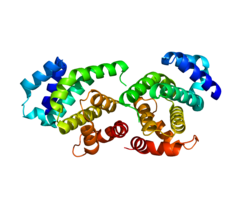Translation initiation is mediated by specific recognition of the cap structure by eukaryotic translation initiation factor 4F (eIF4F), which is a cap binding protein complex that consists of three subunits: eIF4A, eIF4E and eIF4G. The protein encoded by the eIF4G2 gene shares similarity with the C-terminal region of eIF4G1 that contains the binding sites for eIF4A and eIF3. eIF4G2 additionally contains a binding site for eIF4E at the N-terminus. Unlike eIF4G1, which supports cap-dependent and independent translation, the eIF4G2 gene product functions as a general repressor of translation by forming translationally inactive complexes. In vitro and in vivo studies indicate that translation of this mRNA initiates exclusively at a non-AUG (GUG) codon. Alternatively spliced transcript variants encoding different isoforms of this gene have been described.[7]





